|
Posted: 8/14/2018 4:58:58 PM EDT
[Last Edit: BigJimFish]
Introduction
 BigJimFish 8-3-2018 Note: Since the time of this review, Mesa Precision Arms has changed it's name to PurePrecision. This was done because of a trademark fight and didn't have anything to do with the product or people involved in making that product. Though, they have added a number of important in-house production capabilities and partnerships since the the time of this review. I first learned of the Mesa Precision Arms guys when I was doing the Grayboe Ridgeback stock review earlier this year. Prior to using their own branded bottom metal, Grayboe used the MESA bottom metal. While sourcing the bottom metal for the Grayboe review from MESA, they asked me if I would like to do a review of a custom rifle built by them with their soon to be released titanium action. They are a fairly new shop, started in 2017, and were looking to get their name out as well as get a little third party validation that they know what they are doing. I tend to do a lot of research before agreeing to a review. This is because if the product does not do well I will give it a bad review. Bad reviews don't just ruffle the feathers of the folks who make the product, but also tend to make other companies a bit shy about having their products reviewed. These reviews also are of little help to a reader since they just introduce one product from among what is usually a faceless horde of products only to say that it is no good. This doesn't help the reader much since he is still left with the horde to choose from. I avoid all this as much as possible by doing substantial research before accepting a review. What I found researching Mesa is that it is a partnership of two guys with resumes that looked encouraging. Chad Drayer served two years as a scout sniper in the Marines before working for U.S. Optics for seven years. John Hakes also served in the Marines. Since then, John has become an accomplished long range precision hunter, recently added to Proof's pro staff. He built rifles at Red Hawk rifles for a number of years before they decided to stop building rifles to concentrate on online retail. Having plenty of experience at that time, John decided to partner with Chad and start his own shop. John and Chad's history, connections with others in the industry, and what I had read about Red Hawk's rifles during the period John worked there, convinced me that their rifle would probably be well made and so we worked up some specs for one of their specialties, a lightweight Crux hunting rifle to review. 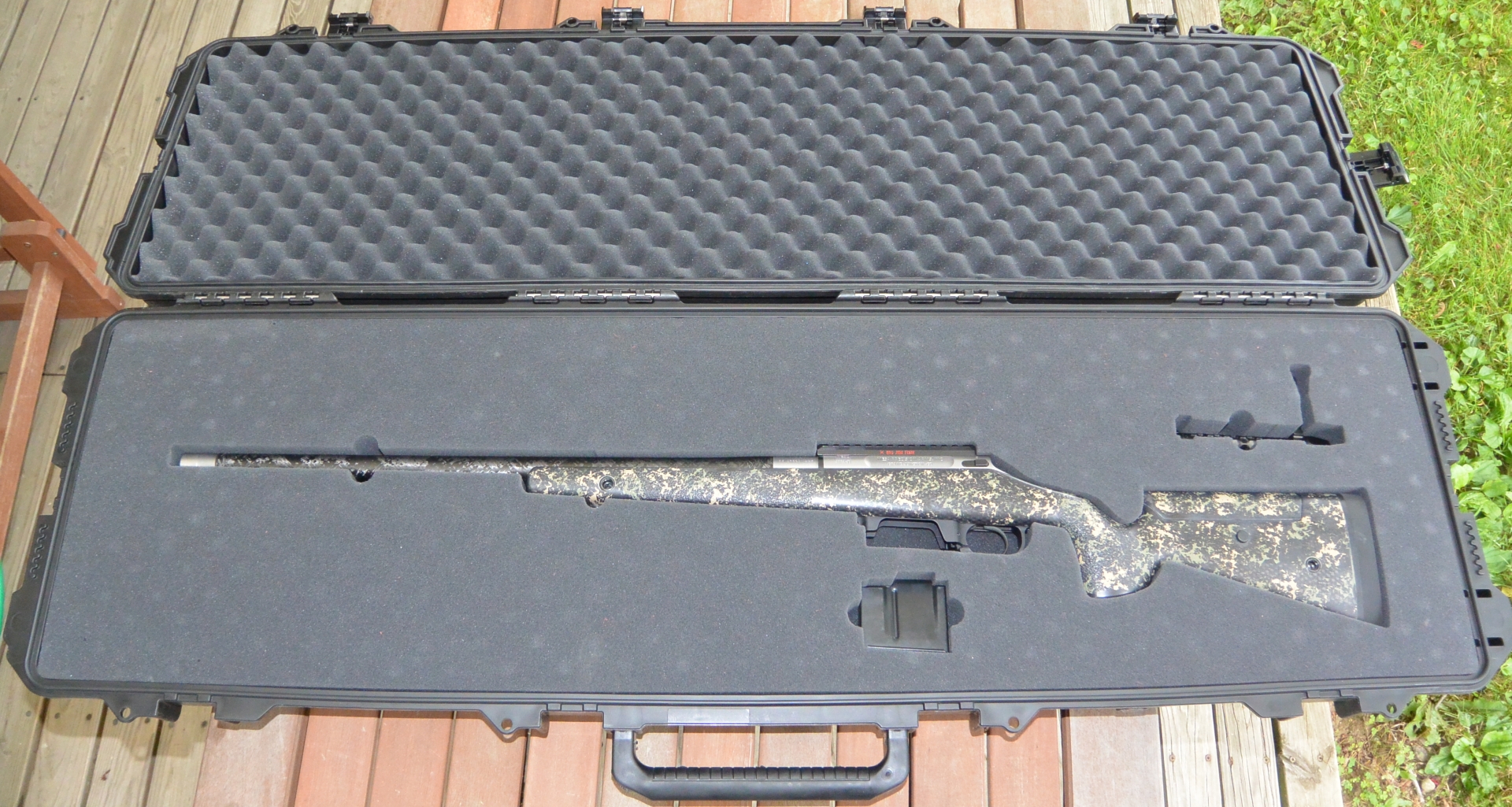 Mesa Precision Arms Crux unboxing Table of Contents Introduction Fit and Finish Components Stock Titanium vs Steel Action Action Trigger Barrel (Update 7-30-2019) Ammo Background Accuracy Testing Federal Desert Tech Copper Creek Hornady Berger (Update 7-30-2019) Norma (Update 7-30-2019) The Shooting Experience Summary Fit and Finish The Mesa Precision Arms Crux arrived in a custom cut foam lined Pelican case looking every bit an object of desire. Even the FFL was impressed. This custom case gave the unboxing the feel of Christmas as a kid. Beyond adding to the initial joy of acquisition, this packaging is pretty important, and functional, for both the long range hunter and competitive shooter. Both of these hobbies involve subjecting your precision shooting instruments to the rank abuse of the American aviation system. A perfectly custom cut foam Pelican style box is really the best way to reliably weather that maelstrom, provided they don't lose the gun outright - never a guarantee. MESA must have, or contract, one of those fancy automated optical foam cutting machines because their fit is perfect. The rifle itself is an arrangement of carbon, titanium, steel, and aluminum in which function flatters form instead of the other way around. The visible carbon in the McMillan stock and Proof barrel see to that, reflecting light like jewelry. MESA surprised me by adding a filled BigJimFish engraving with a little SnipersHide logo on the scope rail in red. It is both a nice touch aesthetically and personally. Taking things apart, the fit and finish continued to impress. The bedding and inletting are sharp and tight, and the fit is good. The Barrel is floated straight in the channel and the inletting shows no gaps around the action or bottom metal. I take all this seriously not because ugly bedding jobs can't be good, but because attention to detail in appearance speaks well of attention to detail everywhere. The finish on the metal components is clean with all the edges well-melted and a nice matching bead blast on the action and barrel. I would suggest plugging the action during bead blast in the future, though, as the raceway would feel slicker without the surface finish and nobody can see it anyway. 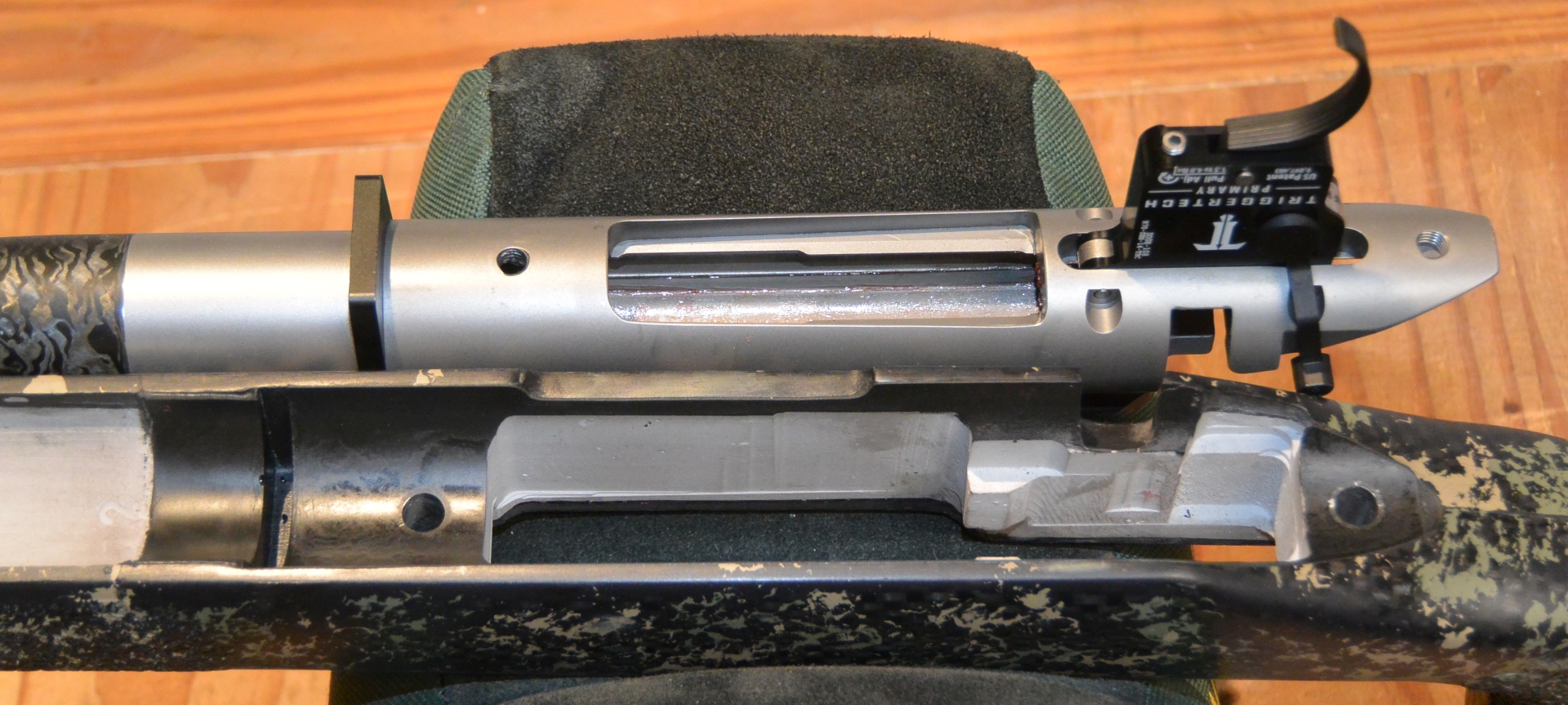 Clean Bedding and inletting on the Mesa Precision Arms Crux Stock The Crux rifle in this review is wearing an adjustable Game Warden stock from McMillan Composite stocks in their Edge Carbon. A carbon composite stock is the clear choice for a custom hunting rifle. This type of stock consists of a molded outer shell made up of epoxy impregnated carbon fiber fabric filled with a lighter density fill material. The resulting product has the strongest, stiffest material on the outside and a lighter fill inside. This works sort of like an I-beam or bird bone: minimizing the material and weight in less structurally critical areas and maximizing it where it matters most. Furthermore, the materials involved are very temperature stable and harmonically dampening. Composite stocks are therefore strong, stiff, light, temperature stable, and harmonically dampening. In fact, they lead all technologies in most of these areas. For these reasons, composite stocks have dominated the competitive shooting sports for 40 years. The only downside is that, with 8+ man hours in making each one, they are not cheap. This labor intensity does have the upside of resulting in a highly customizable product since variations such as more flush cups, different color, different LOP, or different recoil pad do not cause much disruption in an already very hands-on manufacturing process. Composite stocks can also be some of the best looking stocks and can be finished in a variety of ways all the way up to the automotive airbrush painting common in benchrest and f-class competition rifles. These can be works of art on par with custom choppers. Another attractive finish that is a bit less costly is the exposed carbon look on the stock in this review. This look is well suited for a field rifle and can be augmented, as in this example, with a variety of different camo sponge paint accents. The Edge Carbon Game Warden in this review is the first carbon composite McMillan that I have had and I was quite taken with the appearance of the sponge painted visible carbon, especially in conjunction with the Carbon Proof barrel. In both cases, the carbon has the effect of adding depth to the appearance as well as reflecting light differently at different angles to add movement. The appearance is one of luxury, quality, and beauty, and will not be mistaken for cheap plastic even at a casual glance. This look is a great compliment to the superior functional aspects of the carbon composite stock. McMillan is one of the oldest players in the rifle stock market. They have been making composite stocks since the early 70s. Since then they have grown to become the largest composite stock maker in the world by both volume and number of models. Probably most iconic is the M40A1 stock they developed for the Marine Corps in 1975, though the A5, which was developed in 2002 and released in 2003 with a great deal of input from the folks right here at SnipersHide, is currently the most popular model. McMillan is also well represented in the shooting sports and has a long history of being adopted as an OEM for rifle makers' premium models. There are even a few cases where rifle makers intended to use a cheap plastic stock originally but did not make contract accuracy specs with the plastic and ended up using a McMillan to improve the accuracy and make spec. The particular model of stock that I chose, the adjustable Game Warden, offers a very lightweight option for an adjustable cheek piece hunting stock (mine weighs in at just 2.56 lbs bedded) that also accommodates the larger diameter Proof barrel that I would be using. This is not a very common combination of capabilities and it is what I needed. I have high cheek bones and very low tolerance for poor fit of the rifle to the shooter. The bit of three position shooting I have done has given me a great appreciation for the importance of fit to accuracy. I found the folks at McMillan helpful and knowledgeable both during this build process and in the past for other projects when I was not an author on SnipersHide and was instead a less than ideal potential customer trying to jam an Anschutz 54 Sporter into a stock never intended for that purpose. McMillan has gone out of its way on more than one occasion for me. That is really the definition of custom. 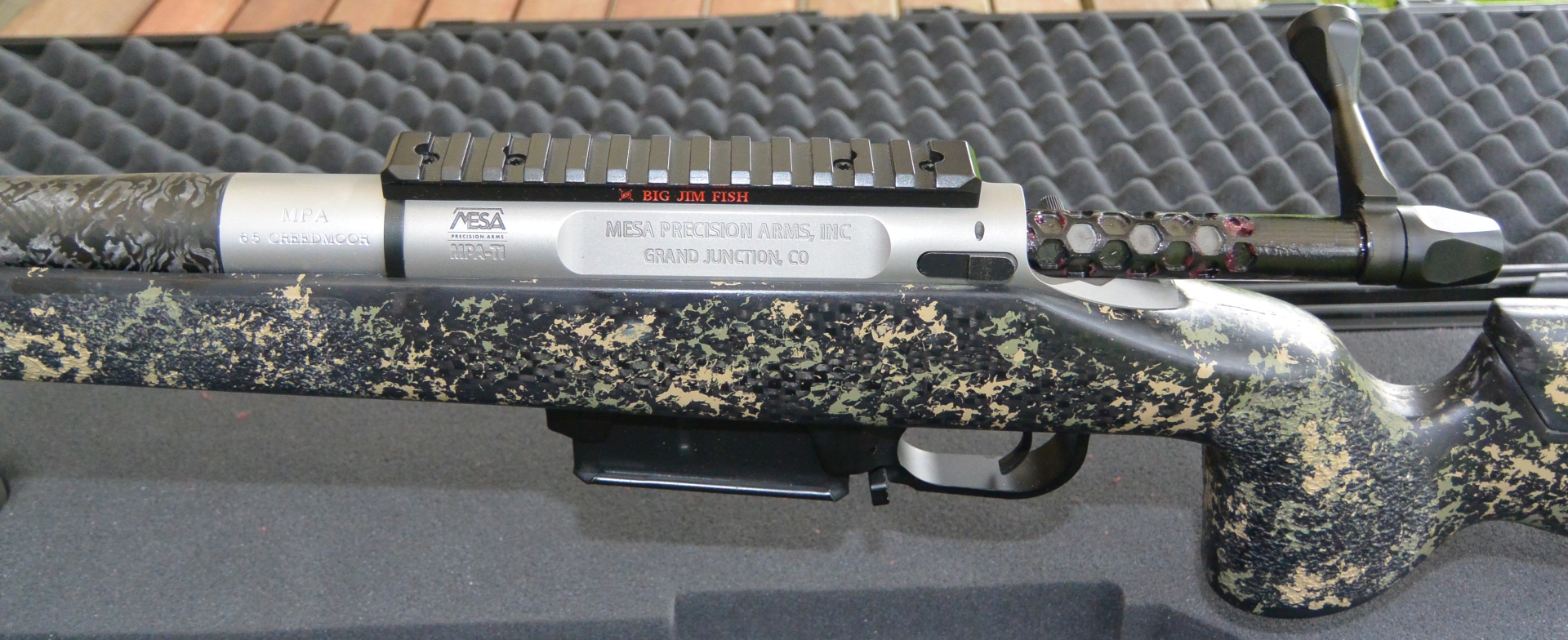 MESA Crux in McMillan Game Warden Edge Carbon stock Titanium vs Steel Action Whether it be guns, golf clubs, race cars, springs, or orthopedic implants, titanium and steel are often suggested as alternative material choices for the application involved. The strength, flexibility, corrosion resistance (in the case of stainless) and lack of toxicity can be quite similar, depending on the alloys involved, between these two elements. In the case of this action, the alloy we will be speaking of is Grade 5 Ti-6AL-4V titanium. Comparing this alloy with the variety of steel alloys used in actions will yield a few general trends. The first and most obvious trend is that the titanium (“Ti”) is about 40% lighter per volume. It is a common misconception that titanium is also stronger. By weight this is certainly the case, but by volume the comparable steels will be a little stronger. Both materials have good flexibility properties in that they flex and return to original size without fatigue, or strain hardening, over a fairly large range. This is why Ti and steel alloys are the most common spring materials in industry. The titanium flexes more easily however, and this does mean that in a Ti rifle your brass casings will flex many times more, wear quicker, and could cause harder bold lift in high pressure loads. While stainless, as its name implies, does have corrosion resistance, it has nothing on Ti, which is basically immune to corrosion at normal atmospheric temperatures even in the presence of salt. Ti can be made fairly hard at about 36 Rockwell C, but steel is commonly harder than that and this hardness, combined with less of a tendency to gall, makes steel actions feel smoother and want for less lubrication than Ti. Despite Ti's corrosion resistance, titanium actions do not run well dry. The dominance that steel enjoys, in terms of prevalence, over titanium does not result from hardness and strength advantages. This dominance has far more to do with the costs of the raw material and, to the greatest extent, costs and expertise to machine. In cost of raw material, titanium is somewhere around twice the cost of steel for similar quality stuff, but in terms of machining, it is often said to be about five times more costly once slower feed speeds, greater tool wear, and various other things like the chance of its little shavings catching fire are considered. The sum of all this comparison is that you are probably not going to use titanium for the PRS rifle that you are going to go through barrels and brass like water with, but if you are looking to make a lightweight hunting rifle, a titanium action that saves you a 1/2 lb is the clear choice if you can afford it. Crux Action The Crux Titanium action is a Remington 700 semi-clone action. It departs from the 700 slightly in the larger, pinned, trapezoidal recoil lug, the side mounted bolt stop, a longer cut for the mag box (works both with AICS mags or internal box mag), and different mountings for the rail or rings. Most 700 chassis and stocks will easily accommodate all this with no alterations, however. The Crux is designed to accept either a rail of your choice cant or Nesika Bay style pinned rings for those looking for a more traditional hunting appearance. The bolt knob on the Crux is also threaded on so if you desire to change it that is not a big deal. The bolt has an attractive hexagonal fluting that I have not seen before. It is a little change in appearance for those looking for different, though it concerns me a little since the individual honey comb cavities have depth, and a front wall, and so could trap a pebble between the back of the ejection port and the front of a cavity arresting the rearward motion of the bolt. The bottom of the bolt is not fluted so it won't scratch the brass and feels a bit smoother cycling. As is often the case on a titanium action, the entire bolt and locking lugs are steel instead of titanium. This, as well as the DLC coating on the bolt, mitigates problems with galling that titanium can have. The steel locking lugs also lessen the springiness titanium has during firing. I did not notice any hard bolt lift on the action even with the lower 75 degree throw that it has to increase bolt cycling speed and make for greater clearance of the scope. The Crux uses an M16 style extractor and a plunger ejector. The extractor is one of the designs I like, though I am not a big fan of plunger ejectors. Plunger ejectors do have the advantage over passive mechanical systems of ejecting the same at any extraction speed, but they can sometimes clog and bind, put pressure on your case in the chamber, and you have no control over how far they throw your brass. I found the fit and finish of the Crux action to be very good. I liked the toolless bolt disassembly feature they added as well. The 75 degree lift did not cause any of the issues with hard bolt lift I was worried about, so I found it a win. The total weight of the action is 20.8 oz with bolt vs. around 29.5 oz for one of the lighter steel custom actions available. This is better than half a pound in weight savings. These actions are not just available in MESA built rifles but can also be purchased alone for $1,399. 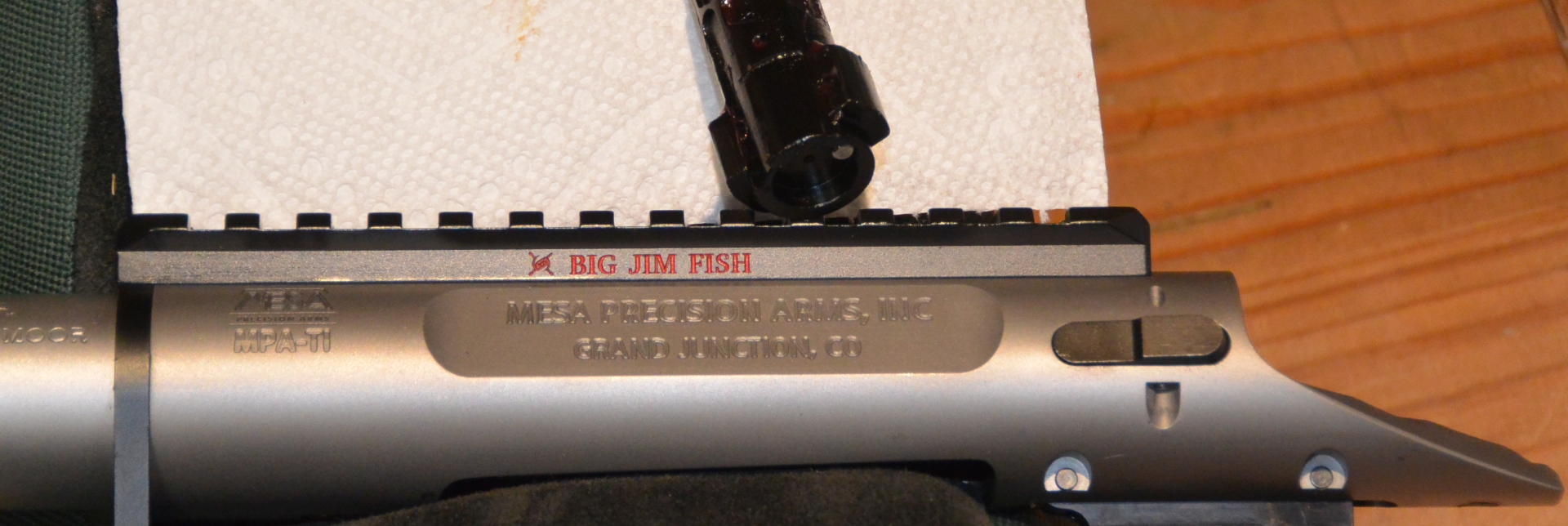 Mesa Precision Arms Crux action and bolt Trigger TriggerTech triggers were one of the many products that I encountered by way of the Mesa Precision Arms Crux rifle review. I vaguely recalled having met the TriggerTech guys a few years before that at SHOT show but the pull weights of the models they had at that time were a bit heavier than I used, I was mostly focused on what optics maker I needed to see next, and the only thing that stuck in my head was the oddity of the rolling sear engagement. Since a TriggerTech primary trigger was included with the Crux rifle, I now needed to look more thoroughly into its technology, understand how it worked, test it, and form an educated opinion. Eventually this would lead to testing the Primary (1.5-4lbs) and Diamond (4-32oz) models as well as TriggerTech sending me their acrylic sided product demonstration trigger. This transparent sided trigger was particularly useful in understanding how their distinct technologies function. Not surprisingly, all of this testing resulted in a subsection that grew became a full review of TriggerTech 700 platform triggers. 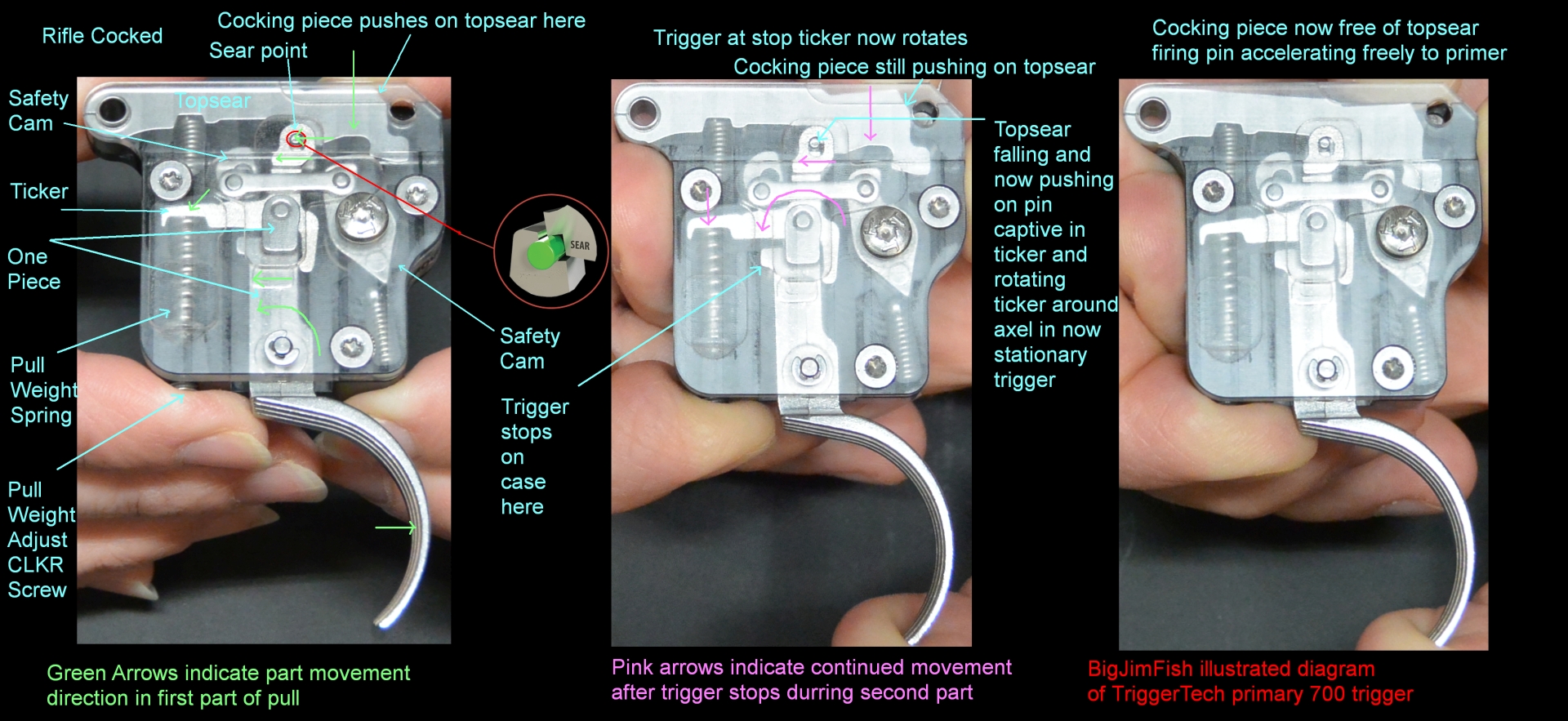 Illustrated diagram of the two part release sequence of a TriggerTech trigger. Barrel The barrel of a hunting rifle has always been a place of manifold compromises. Making a barrel light is no problem. A featherweight contour barrel is less than 2 lbs for a 26" barrel. Unfortunately, it is very difficult to be accurate with this. While the mass of the rifle is part of this difficulty, it is a small part. The whipiness, lack of thermal mass, and small surface area for heat dissipation are larger difficulties. These light contour barrels flex easily and so if the crown is not exactly on a vibration node, shots are thrown wildly. This can be addressed, to some extent, with careful hand loads (not something hunters are really known for), but that still leaves the heat dissipation problems. With so little steel to share and radiate the heat of shots, the barrel overheats and looses accuracy in just a few shots - often, as few as 3 or 4. Fluting has also been sought as a solution, but it saves little weight and often creates problems of its own having to do with uneven cooling and uneven effects on stresses in the barrel created during the manufacture. Fluting looks tacticool, though, and that is really the primary reason folks do it. Carbon fiber, being light and stiff, has been sought as a solution for some time. The idea is simple: Wrap a really thin steel barrel with carbon fiber and it becomes both light and even stiffer than a steel barrel of the same weight. The difficulty is that carbon fiber is an excellent insulator across the grain. It is therefore tricky to keep the POI from shifting as the barrel heats up. It is also difficult to keep the carbon wrap adhered to the barrel with some of the resulting inferno-like temperatures resulting and the difference in the rates of expansion between steel and the carbon composite. I remember when the first carbon wrapped barrels starting coming out and they were pretty terrible. They didn't just heat up and walk shots around, though they certainly did that. They also tended to delaminate such that you could spin the carbon tube around the steel barrel inside like a wheel on an axel. This, unsurprisingly, could even lead to catastrophic barrel failure though, it would not in the barrels Proof is producing today, as the steel core is pressure tested alone. Just as there is a lot of variation in core dimensions between different carbon composite barrel makers there is also a great deal of difference in the resin used to hold the carbon to the core, the manner of application of the carbon to the core, the geometry and alignment of the carbon in the barrel, and the composition of the resin used to bind the carbon. It is most accurate to view each of the different carbon utilizing barrel makers now in existence as entirely different technologies from each other. 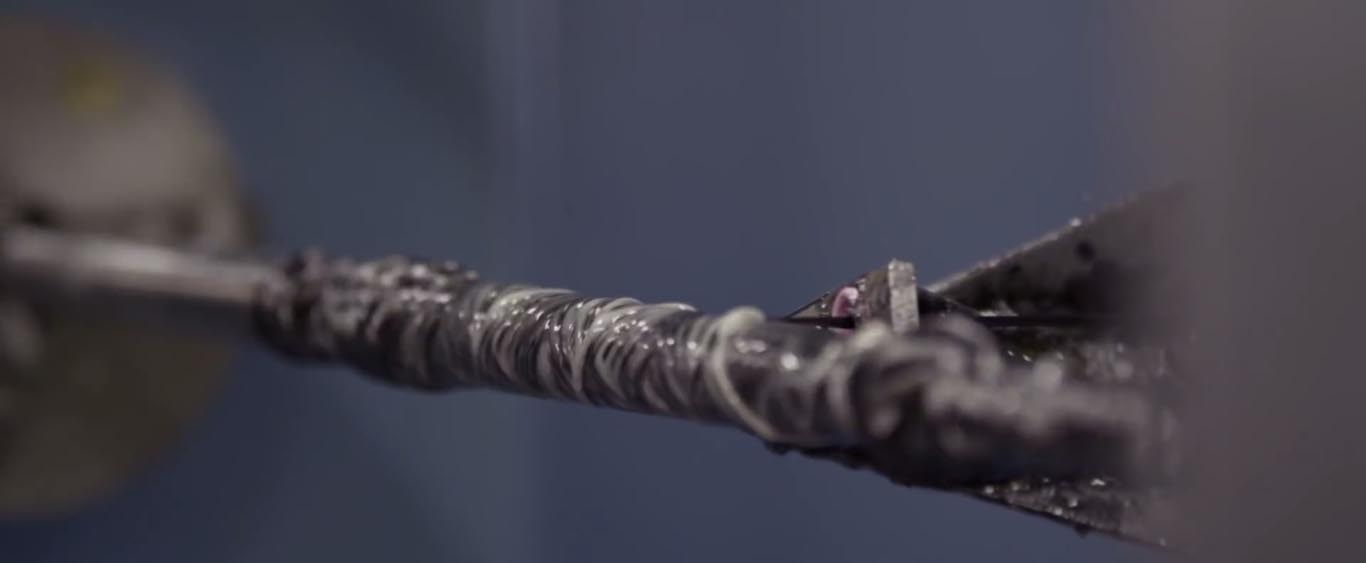 Proof 's unique winding process is tailored to the specific caliber an utilizes carbon threads rather than fabric. So, when Proof sort of re-introduced itself at Shot Show a few years ago, I was pretty skeptical. Since then, though, I have heard good things regarding both the accuracy and heat dissipation of the barrels. My experience so far is that the Proof carbon barrel is plenty accurate, going less than .5" @ 100 yds with one of the tested ammunitions and being close to that with most of the ammo tested. After further testing, (7-30-2019 update) I have become convinced that the changes in barrel harmonics which result from a combination of the added stiffness of the carbon and the vibration absorption of the material result in a barrel that is more tolerant of different loads. This is a very big deal for those shooting factory loads or .22lr as there will be a wider variety of ammo that shoots tolerably well in the barrel than in a conventional steel one. The Proof barrel seems to heat up and cool down at about the same rate as other barrels of similar contour, though this is a rough estimation since I do not have other 6.5CM rifles for a direct comparison or the sort of laboratory thermal imaging best suited for the analysis. Still, if it was a whole lot worse, you wouldn't need lab instruments to tell you. The one negative that I have noticed is that the Proof barrel gets dirty significantly quicker than other match barrels I have and it takes longer to clean. It is possible that this could be a result of the throat surface and not the barrel itself. I don't have a high rez bore scope to tease this out. I also noticed some break in (easier cleaning and less fouling) than when new after a hundred rounds or so. I don't usually notice that on a hand lapped match barrel. While I am not sold on carbon wrapped barrels as an all-around upgrade for everyone, do to the harmonics advantages, I am getting closer to that stance and I certainly think that they are the clear solution for lightweight hunting rifles. Furthermore, I am very interested in trying a proof .22lr barrel as the harmonics advantages there could be decisive if proof has also figured out the unique challenges of .22lr barrel making. Since .22lr barrels run to incredible round counts, the added cost of a proof barrel for this application is a non-factor. Proofs carbon wrapped barrels give you the accuracy of a much heavier steel barrel, as well as added ammunition tolerance due to improved harmonics with cost, about an extra $500, being the only downside. In the case of my rifle, the Proof barrel weighed in at about 3.2 lbs with an equivalent contour steel barrel at over 4.8 lbs. That 1.6 lbs weight savings was the largest for any single lightweight component by a large margin. Lastly, Proof feels the need to call standard barrel contours by the wrong names for what I can only imagine are indecipherable and indefensibly confusing reasons that I am sure led many to find their barrel does not fit their stock. A Proof Sendero, for instance, is bigger than everybody else's Sendero. It is my understanding, though I did not double check this, that their light Sendero is actually a Sendero contour. Fortunately for me, the fine folks at McMillan were aware of the issue and saved me the headache of a size mismatch. Ammo Background I have been hearing for awhile that through changes in the automated loading equipment available, as well as changes to importing arrangements, much better loaded ammo is now available and for more reasonable prices. While I certainly expect that ammo, like most things that are manufactured (and, unlike say pharmaceuticals, subject to actual free market pressures), will get both better and more affordable, ammo has some unique issues to overcome regarding the ‘getting better’ part. The issues stem not from making ammo more uniform, but rather from its fit to any particular rifle. Much of accuracy derives not from the uniformity of the ammo but from its fit to the rifle. This is why some competitive .22lr shooters go to all the work of sending their rifle to a testing facility and then buying an entire lifetime worth of ammo in one purchase. Lot testing is a roundabout way of getting to what handloaders do for centerfire with load development. A handloader often starts with a brass and bullet he intends to use and varies the powder, charge, seating depth, and neck tension to find a combination that fits the rifle best. The theory of why this matters so much has to do with how a barrel vibrates, creating nodes and internodal spaces, as well as with how the bullet exits the case and enters the lands. Basically, you want it to enter the lands straight and exit the barrel at a node. This can all be even further complicated if you shoot long range and therefore need the standard deviation on the velocity to be low, want a high velocity, and might even be tempted to try those devilishly picky VLD bullet oglives that result in lower drag but also make you pull your hair out. This all makes the manufacture of precision loaded ammunition much trickier than just putting some high tolerance components together carefully, within SAAMI standards, and shipping it. Some combinations have a good fit in more rifles than others but you need to do a lot of different testing to find this out and, in the end, your results will still be varied. I am saying all this because the data you are about to partake of is affected by all of these things. Being the best in one rifle does not mean the best in all rifles and being the best on average for all rifles might not mean the best for yours. This is an interesting test nevertheless for giving you an idea of the sort of results you might expect using a variety of excellent factory loaded ammo in an excellent custom precision rifle.  A nice day of testing the Mesa Precision Arms Crux with the family at Rayner's Accuracy Testing Testing of the rifle took place on a couple hot and sultry summer days that proved to have almost non-existent wind. Because of the heat I only did 10 rounds between barrel cooling breaks and, following the opening up of the last FGGM group, I decided to clean every 20 rounds. That accuracy drop, as well as the number of patches per cleaning, suggest that this barrel fouls quicker than previous barrels I have had. This could also perhaps be the 6.5CM caliber as this is my first 6.5CM, though I doubt that plays any role. Some of the testing was done from cement benches and some from steel benches as a couple different ranges were used. A Magnetospeed Chrono was used on some days and an Oehler 35P on others. All groups were fired using a Sightron SIIISS624x50LRFFP/MH (that will be reviewed later this year) mounted in a Bobro dual lever precision optic mount. (review link). I used a Bulls Bag front bag and a rear bag of my own making. Magnification, rests, and non-free recoiling position considered, I think it would be fair to say that my hold was worse than .25" more than it was better in this configuration. The biggest challenge related to accuracy testing for the MESA Crux in 6.5CM is what you might call the caliber to weight ratio. The Crux is a very lightweight hunting rifle. The model can be made as light as 6.1 lbs and the particular configuration I assembled, with a little longer and larger contour barrel, adjustable stock, rail, and DBM is still only 7.38 lbs. That light weight, coupled with the moderately powerful 6.5 CM cartridge results in significant movement of the rifle during firing as the rifle is pushed back into the shooter before the bullet has left the barrel. This is always the case but is more pronounced the lighter the rifle and more powerful the cartridge. Given the limitations of factory ammo, non free-recoil position, and a very lightweight rifle, I was pretty apprehensive going in to the testing. I was quite pleased when the rifle proved to be .5" with one of the ammunitions tested and consider this to be an excellent result. 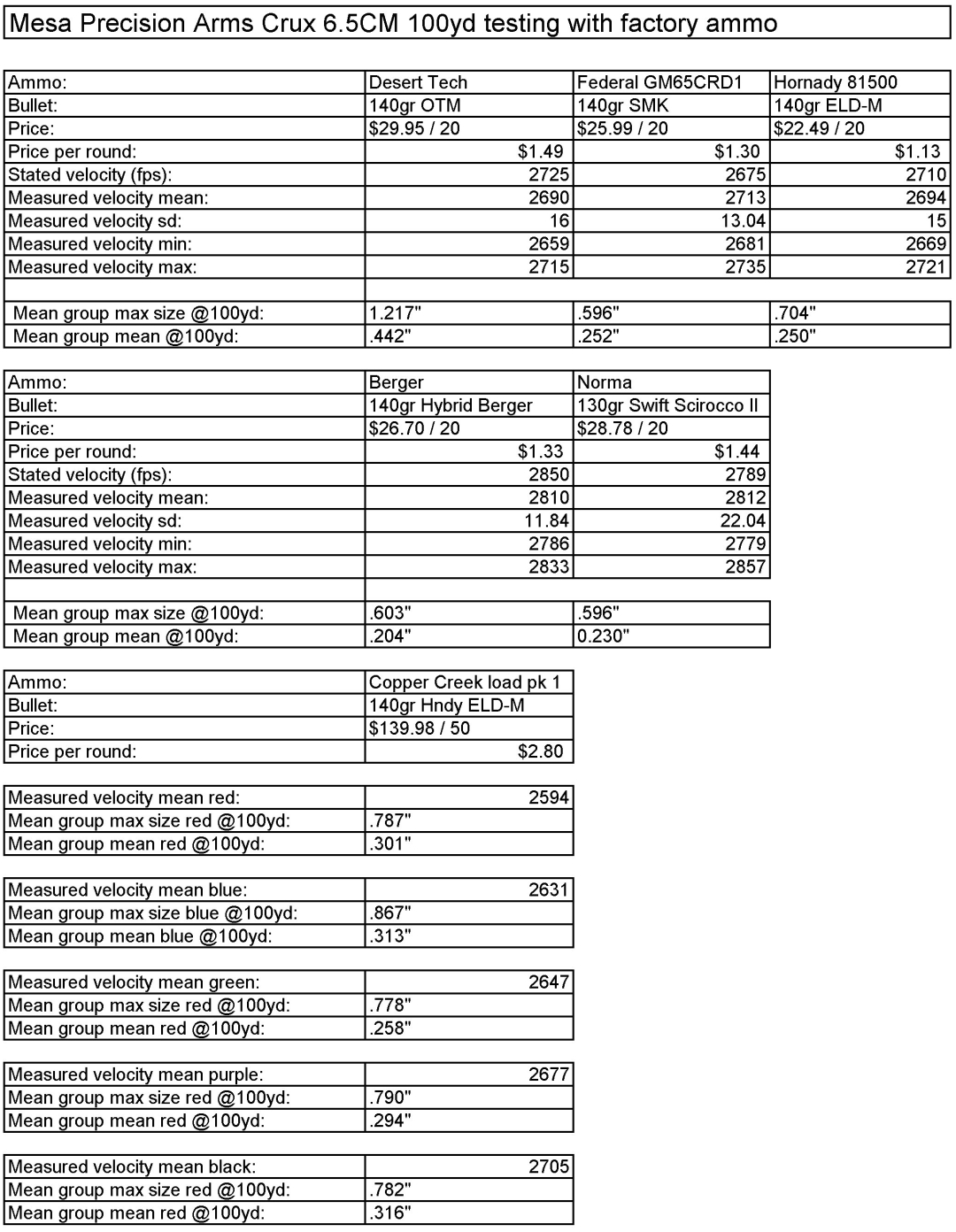 Group sizes and data for factory ammo from the Mesa Precision Arms Crux Federal My brother and I have had a long standing argument about Federal Gold Medal Match ammo. His position was that it is excellent and he uses it as his regular fodder for his rifle, which was actually designed for the round. My position was that Federal, though once the only game in town for quality factory ammo, was probably not the leader anymore and middle of the pack for premium ammo at best. I had my doubts about it averaging .5" @ 100 yds as I had fired FGGM ammo in a lot of different rifles over the years and never seen it do that. Now I have to eat my words and I have mixed emotions. On the one hand, things shooting well is great; on the other, my brother should never be right. Shooting the FGGM in the MESA Crux, I could see that it was just hammering right away. Because of this, I got a little too aggressive with my holds and actually ended up adding .2" to the third group I shot. That group was also sub .5" out of the rifle I just changed where it was pointing in a failed, tail chasing, attempt to tighten things up even more. I corrected my poor behavior to spit out another clean group for the third group. I think the fourth group opened up due to a dirty bore, though this is conjecture. With only had about 60 rounds down the barrel at the time, of which most were at long range steel, I was not accustomed to how quickly it fouled. In any case, I didn't run it to 25 rounds between cleanings after that. It is also notable that, in addition to being a sub .5" ammo out of the Crux, the SD of the FGGM was also only 13 fps. While that is not single digit, it is pretty darn close. Really, sub .5" @ 100yds with an SD of 13 fps is what you might expect to be entering a serious competition with. In a lightweight hunting rifle with off-the-shelf factory ammo, it is quite impressive. 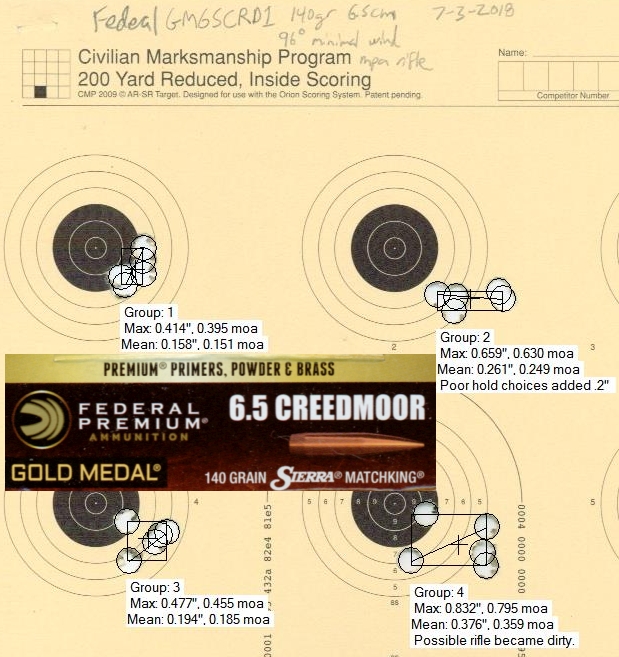 Federal GM65CRD1 140gr SMK testing w/ Mesa Precision Arms Crux Desert Tech Desert Tech is probably better known for their rifles, which are totally unique designs that are unusual both in their focus on bull pup configurations and in their easy caliber convertibility. The rifles are quite innovative and have a very good reputation. The ammo has likewise been gaining an excellent reputation, particularly in the 6.5CM caliber which has a .5MOA guarantee out of the Desert Tech rifles. Frank, as well as a variety of other reviewers have also seen those sub .5MOA results. This is probably a good time to mention again the importance of ammo and rifle fit. In this case we have an ammo with a .5 MOA guarantee that has done so for a variety of folks whom I trust. We also have a rifle that has done .5 MOA with the Federal ammo I tested and wasn't really far from that with the Hornady either. Together though, it is not good. This ammo is just a bad fit for this particular rifle and that did not change with or without compensator or with or without Magnetospeed. Ammo to rifle fit is just a huge factor to the performance of you overall shooting system and is independent of the quality of the rifle or ammo. If you want good performance with factory ammo in your rifle, you are going to need to test a variety of quality ammo. If you want good performance with handloads you are going to need to spend time developing a load, preferably with your reloading equipment at the range. Fit is important. 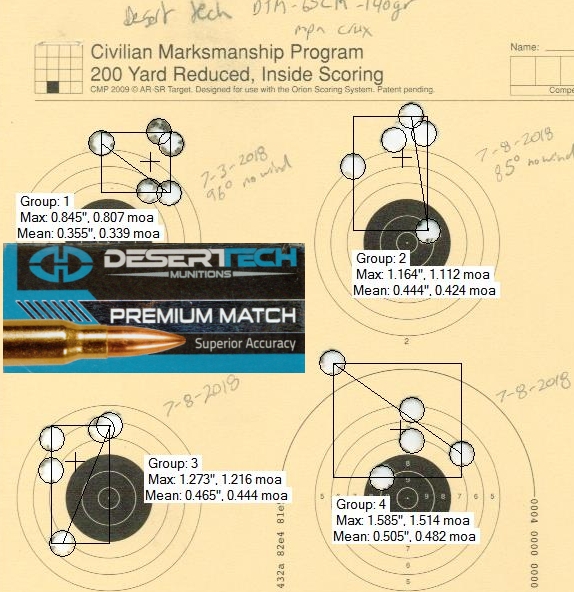 Desert Tech 140gr OTM 6.5CM w/ Mesa Precision Arms Crux Copper Creek Copper Creek Ammo is a relatively small scale U.S. maker that offers both standard loaded ammo and a unique two-stage load development option that sort of approximates the handloading procedure by varying first powder charge and then seating depth. In the procedure, you fire one group with each of five charges, pick the best, measure your chamber with the Hornady OAL gauge, and have them send you a second set of loads. These next five loads each have the charge you chose but with a different depth of seating. I was intrigued by this as it attempts to overcome the biggest challenge that factory ammo has, namely, the aspect of fit to the rifle. Since it has been my experience that something always goes at least a little wrong, I had them send me ten instead of five of each charge weight: . basically, a double load development pack. The Copper Creek load development pack did not feel quite as enlightening in this 6.5CM as it had in the .223. This may have something to do with 6.5CM, with it's long neck and short fat case, being less finicky than .223. Though the green velocity proved the best, it was not a whole lot better than some of the others or, really, that great itself. The difference between the best averaging load and the worst was less than .1" and all loads were just over .75" on average. My inclination, should I be handloading and get this data, would be to change bullets or powder since this combination just seems to be chasing its tail around. Because Copper Creek has the same sort of huge variety of options that you have when handloading, I would do the same with them. Copper Creek can make a load development pack with any projectile made so you are not limited in your bullet selection. Speaking of options and removing limitations, Copper Creek gives you a lot of options as they can simply make ammo for you to your own already tested load specifications. They also keep the load data for any ammo you've developed with them on file permanently and will give you the load recipe after you have purchased only 100 rounds of loaded ammo. This is a pretty astounding degree of customizability. 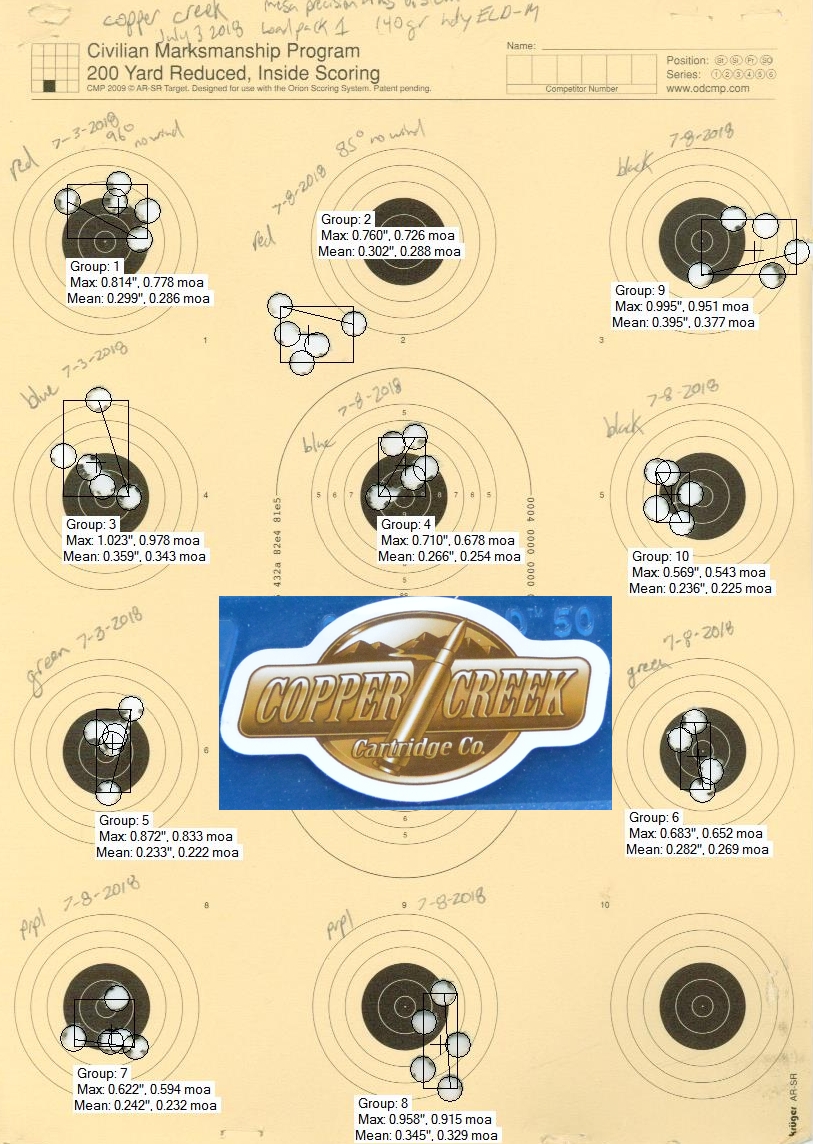 Copper Creek 140gr Hornady ELD-M load pack 1 testing w/ Mesa Precision Arms Crux Hornady Hornady has been making a big push lately into long range precision shooting with their 6.5CM cartridge and the support they offered it at launch by providing high quality, affordable, loaded ammo for it. There has been a bit of rumbling on the street that they have loosened up a little on the QC with these loads, though, and that, while still good, they are not as good as they were. Hornady has also done a lot of work on polymer tipped bullets, overcoming the intrinsic accuracy challenges in order to realize aerodynamic advantages. The Hornaday ammo behaved very differently on the two days in which it was shot. The first day, at 96 degrees, and with the Magnetospeed, it shot a very loose group exceeding 1". The next day, at 85 degrees with no Magnetospeed it shot much better. It went sub .5" on one group, had another that was sub .2 until it got a flier and had nothing even close to .75". Basically, it felt like a different ammo altogether. Since the velocities looked very close, my thought is that the slight change in harmonics from the Magnetospeed was not good for it. I have not seen this effect myself with other ammo or rifles, but others have said that a Magnetospeed tightened or loosened their groups to a noticeable degree. With a mean group mean of .250" (actually a little under the Federal's .252",) I would not be terribly surprised if I could go sub .5" on average with this Hornady if I had another box, preferably from the same lot, and did all rounds without the Magnetospeed. 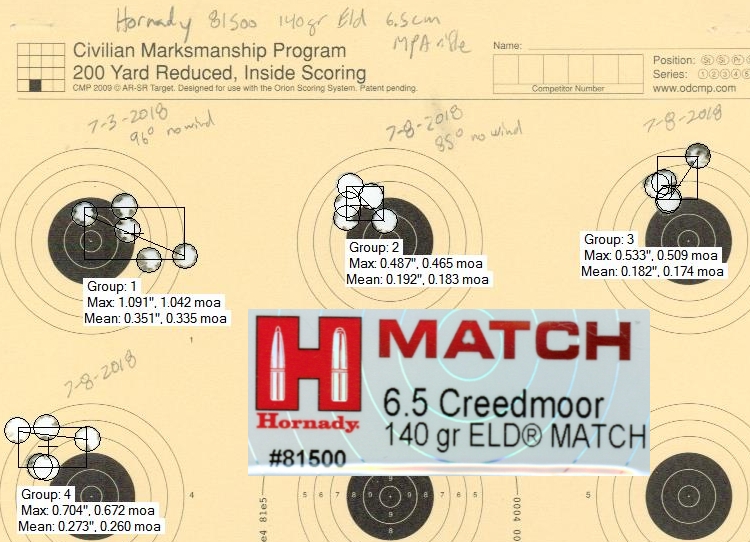 Hornady 81500 140gr ELD-M testing w/ Mesa Precision Arms Crux Berger The story of Berger ammo over the last couple of years is a little complicated. What is now Berger loaded ammo was recently known as the Applied Ballistics Munitions line of loaded ammo and was developed with Bryan Litz (hence the original name). The reason for the name change is that Berger has been acquired by the Capstone Precision group and they wanted their, Berger, brand on it. This was purely a marketing decision. The ammo is made on the same machines. Another change for Berger is that it moved all of its operations back to Phoenix AZ last year. This is where Berger started and where some stuff always was. The last owner of Berger had moved some things to California and Capstone has moved it all back to AZ. The move caused some disruption of supply of loaded ammo and components, but all is back up and running now and the distribution channel is well stocked again. Now, about Capstone Precision. Capstone is a combine of Berger, Lapua, SK, and VihtaVuori powder. This is not a buy-a-name-and-gut-it operation. CPG is maintaining full production of bullets and ammo both sides of the big pond. This means that they actually have two physical bullet factories, ammo loading facilities, and two different development teams as well. I have high hopes for the partnership: Perhaps some Lapua quality .22lr produced stateside, for instance. As for this particular 6.5CM ammo, it is loaded using Lapua brass with small rifle primers. Really, 6.5CM should have been spec'd for small primers when Hornady came up with the round. Small primers can take higher pressures and the obvious market for the cartridge was long range shooters who would want to do that. Alas, that is not how the specs were written. Lapua / Berger has thus improved the cartridge by making this change. After shooting the ammo I found it quite notable that, despite being one of the heaviest bullets tested, it was also the fastest and noticeably the lightest recoiling. Despite being fired from a very lightweight titanium and carbon rifle, this stuff felt like shooting a .223. I'm not sure what manner of sorcery they are employing to get all this done, but I'll take it. The Crux rifle clearly loved the round and grouped very well with it. The standard deviation of the Berger round was also excellent at 11.84fps and it is pretty affordable at $1.33 a round. 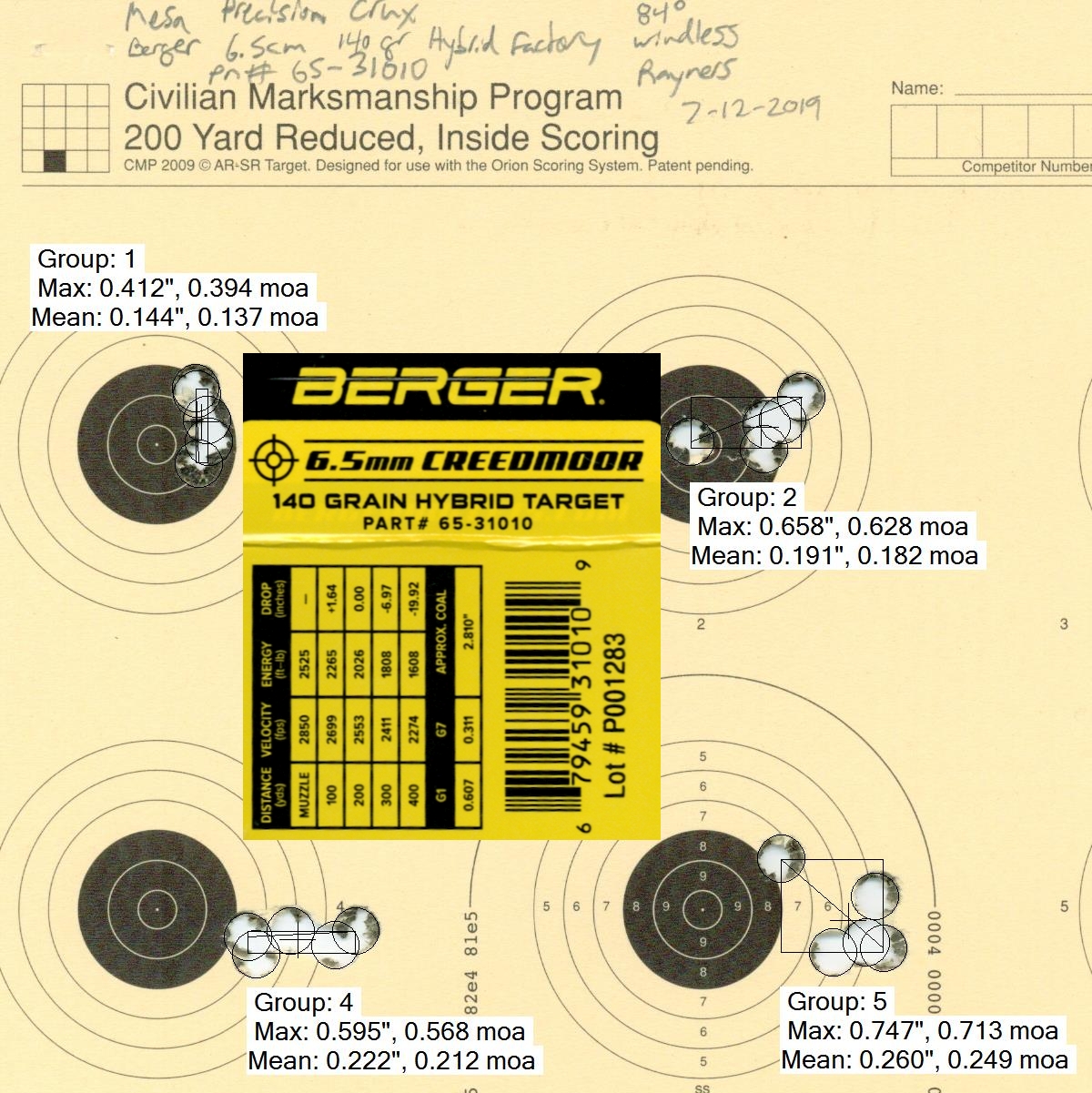 Berger 140gr Hybrid testing w/ Mesa Precision Arms Crux Norma No doubt most shooters are familiar with Norma. The brand has been around for more than 100 years and is probably best associated with big game ammo and ammo for the shooting sports. Norma was originally a Swedish brand and still has a factory located not very far from Oslo in the picturesque beauty Sweden is well known for. It also now has one located in the near opposite climate of Tampa Florida. Norma is now owned by the huge, diversified, multinational military industrial complex company Ruag Ammotech, and this is where things get a little complicated. Like most big military industrial complex companies I have dealt with, Ruag is very cagey and opaque. This is probability even further complicated by their European nature along with the language barriers and different cultural and business norms associated with that. Ruag produces ammo under the brands RWS, Geco, Rottweil, Norma, Gyttorp, and Ruag. All of these it owns. Until recently, it also produced ammo marketed in the U.S. under the brand Prime, with which it had an acrimonious, very public, and lawsuit strewn divorce. Ruag has a number of different production sites in Germany, Hungary, USA, Sweden, and Switzerland. This year, when I spoke to the Ruag guys at SHOTShow, I made inquiries as to which products in which lines were produced where because the factory something is made at tends to mean more than the brand on it. I did not get anywhere. What I have learned, mostly from reading the boxes, is that both the 6.5CM Norma that I tested in the Mesa Precison Arms Crux and the .223rem that I tested in the Kelbly's Atlas are both of Swedish production. This despite the .223rem bearing the branding "Norma USA" and Norma having a production facility in the USA. I also know that Ruag has precision rifle ammo production capability in at least one other factory. That factory being a Swiss one that produces the Ruag Swiss P line of ammo and, I believe, also produced the Prime precision rifle ammo. So, for those wondering if the Norma stuff is the former Prime stuff, I don't believe so, though I have not reverse engineered rounds to know definitively. In any case, the 6.5CM Scirocco II grouped well in the Mesa Precision Arms Crux rifle and actually tested a little faster than advertised on the box. The standard deviation in velocity of 22.04fps was the only aspect of performance that was less than ideal. Probably the most interesting thing about the Scirocco II was that it actually features a hunting bullet designed for medium-sized game instead of the match bullets all the other ammo I have tested used. Given the greater design challenges of making a hunting bullet, I find both the price and performance of this round particularly good and it pairs well with the Mesa Precision Arms Crux lightweight hunting rifle that I used it in. 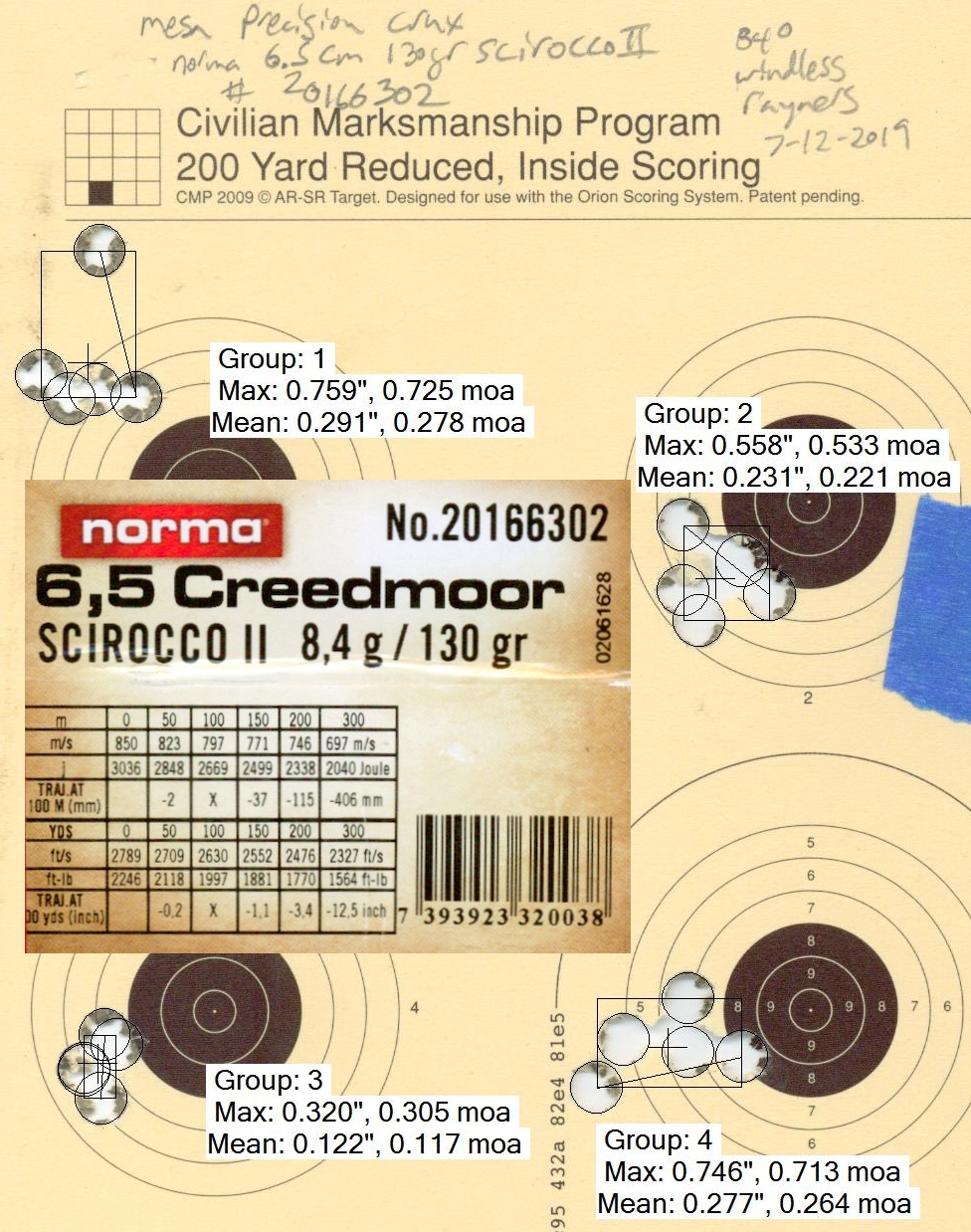 Norma 130gr Scirocco II testing w/ Mesa Precision Arms Crux The Shooting Experience I already mentioned that I was concerned that the light weight might lead to problems in the accuracy testing. In an effort to mitigate this, I actually added a strap-on shoulder pad for the second and third days of testing to minimize the bounce due to the movement my pulse generated on such a light rifle. I was a bit concerned about felt recoil as well and picked up a compensator to try out. In the end, I tried the rifle with and without compensator as well as with and without the strap-on shoulder pad I brought along to help with pulse bounce. I needn't have been worried: the McMillan composite stock and decelerator pad combined to take the bite out of the only moderately powerful 6.5CM cartridge. The compensator was nice for some of the testing where I was shooting all day long but would be of more use to a hunter in protecting the crown than in taming the recoil. Shooting steel at distance, the 6.5CM showed its advantage. It is noticeably better than a .308 at that range and had no trouble reliably dropping shots on target out to the 1k yard maximum range I have at my disposal. I was very on the fence about doing a 6.5CM. In fact, I am actually still on the fence about it. An ~1.5k round barrel life may be considered moderate, but for a guy who shoots mostly .22lr and .223rem, it looks pretty short. I went back and forth a long time between the longer lived, heavier hitting up close, .308 and the better long distance 6.5CM ballistics. In the end, I decided it might be fun to try to blow up groundhogs from the next hill over. I can always make the opposite choice next barrel since the bolt head is the same. Caliber may originate from the Greek name for a shoemaker’s last, but it always feels like it should have come from something that meant compromise. 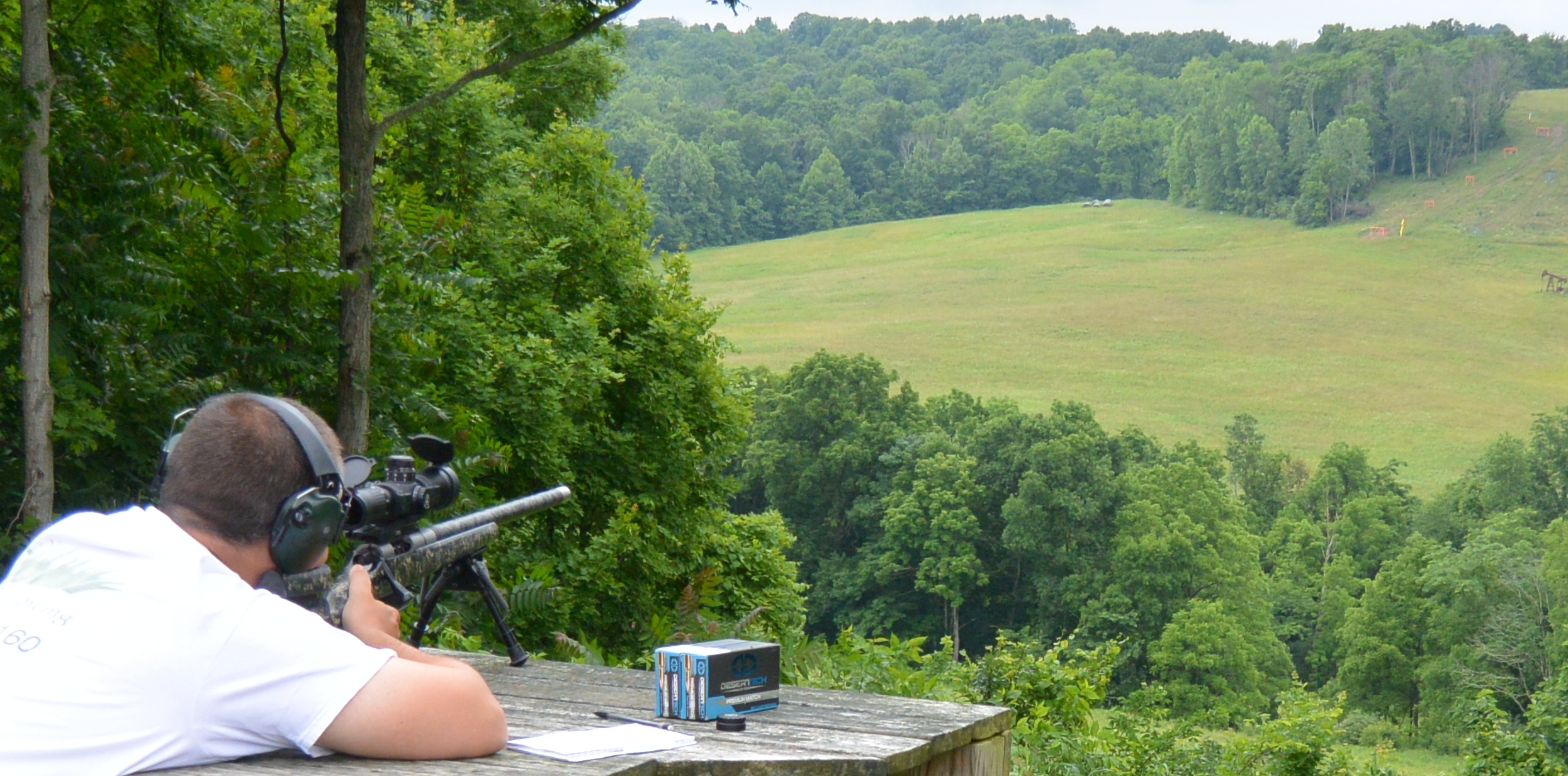 Shooting the Mesa Precision Arms Crux at the 700yd steel at Rayner's Summary John and Chad at Mesa Precision Arms have a lot going for them as they enter the increasingly competitive rifle making industry. Their military service credentials, previous work experience, hunting and competitive credentials, and industry connections are all first rate. They are on point with a variety of industry trends I have noticed, from the components they use to the shape of their supply chain. Much of their marketing also strikes me as cutting edge. Their Facebook and Instagram accounts are regularly updated and the quality of the photography in their posts is professional level. They are really worth "friending" or "following" just for the photos even if you aren't looking for a rifle. Most important to their success, though, the rifles perform well. The price of the Crux rifle as tested is $4,799. When comparing this to six other custom shops, whose quality I also have faith in, Mesa Precision's price came out exactly in the middle. I was worried going into this review that it would be difficult to get the sort of performance I expected from the rifle. This was a combination of not knowing the MESA guys very well, the extreme light weight of the rifle, and the plan to focus on factory ammo performance. I would have been even more worried had I known a few of the ammo makers that were originally lined up were not going to be able to come through leaving only four factory loads. Despite all these factors, the Mesa Precision Arms rifle shot its desired .5" @ 100yds pretty quickly with the FGGM 140gr and went on to show some pretty good potential with the Hornaday as well. I am quite pleased with the performance of the rifle. On the other side of that light weight, the 7.39 lbs of the Crux in the configuration I received (it can go as low as 6.1 lbs) was a dream to carry. The carbon barrel, carbon stock, and titanium action alone saved roughly 3 lbs over the parts conventionally used, any you feel this savings strongly. Probably the most unique aspect of Mesa Precision is its focus on the long range hunting market. Like most makers, MESA can build whatever you want: from a lightweight hunting rifle to a variety of discipline specific rifles. For most makers, though, the hunting rifle is the afterthought and usually looks more like a stripped down model than a premium one. Mesa is really focused on making their long range hunting rifles premium from the Proof carbon barrels to the McMillan carbon stocks to the Trigger Tech triggers. Even the packaging, in a Pelican iM3300 case with perfectly custom cut foam, is premium. Mesa's take on the hunting rifle goes further than just premium though. There are lots of premium European hunting rifles. What Mesa makes has a distinctly American flavor in features certainly, and usually in the country of origin of the parts as well. The highly compatible 700 clone platform, M5 / AICS mag option, high tech stock and barrel, rail optics mounting option, calibers commonly chosen, and focus on long range performance are very American. I have not seen other makers focused on what a premium American hunting rifle should be, and that is very much what the Crux is. For a limited time, readers of SnipersHide will receive 5% off Mesa Precision Arms products with coupon code #snipershide To check out the other reviews this year check out the 2018 BigJimFish review thread. 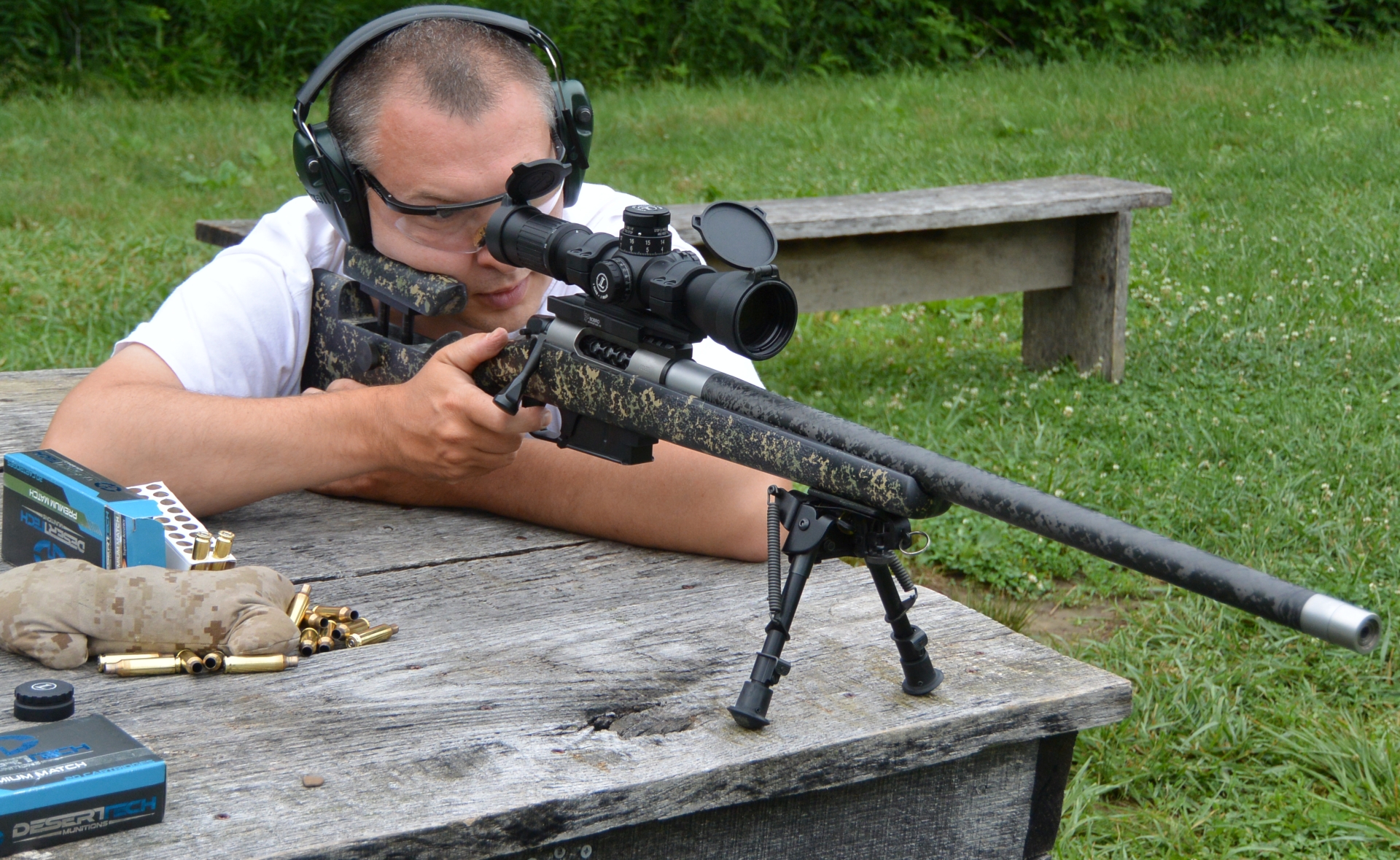 Shooting steel at 1000yds with the Mesa Precision Arms Crux |
|
|
|
|
Updated 7-30-2019
New testing done with Berger and Norma ammo. Sub-section for the Proof barrel also changed to reflect new thoughts on barrel harmonics. More about the updates and this years reviews in my 2019 review thread. |
|
|
|
 Win a FREE Membership!
Win a FREE Membership!
Sign up for the ARFCOM weekly newsletter and be entered to win a free ARFCOM membership. One new winner* is announced every week!
You will receive an email every Friday morning featuring the latest chatter from the hottest topics, breaking news surrounding legislation, as well as exclusive deals only available to ARFCOM email subscribers.
AR15.COM is the world's largest firearm community and is a gathering place for firearm enthusiasts of all types.
From hunters and military members, to competition shooters and general firearm enthusiasts, we welcome anyone who values and respects the way of the firearm.
Subscribe to our monthly Newsletter to receive firearm news, product discounts from your favorite Industry Partners, and more.
Copyright © 1996-2024 AR15.COM LLC. All Rights Reserved.
Any use of this content without express written consent is prohibited.
AR15.Com reserves the right to overwrite or replace any affiliate, commercial, or monetizable links, posted by users, with our own.

